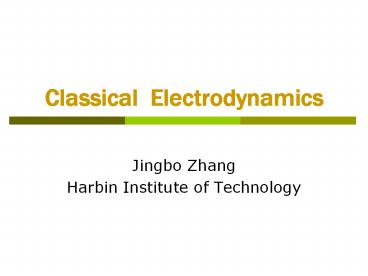Classical Electrodynamics - PowerPoint PPT Presentation
1 / 12
Title: Classical Electrodynamics
1
Classical Electrodynamics
- Jingbo Zhang
- Harbin Institute of Technology
2
Chapter 1Classical Electrodynamics
- Section 3
- Electrodynamics
3
Review
- In last two sections, we obtained two set vector
partial differential equations for electrostatics
and magnetostatics, respectively.
They seam to be the independent theories.
4
1 Electric Charge Conservation Law
- Electric charge is conserved and electric current
is a transport of electric charge. - The electric charge conservation law can be
formulated in the equation of continuity,
It means that the time rate of change of electric
charge density is balanced by a divergence in the
electric current density.
5
2 Maxwells Displacement Current
- In magnetostatics, we got the source equation for
magnetic field,
- In the case, we used the condition of stationary
currents,
- However, in general case of non-stationary
sources and fields, we must follow the equation
of continuity,
6
- Maxwells source equation for time-varying field
The second term on the right side, is so-called
Maxwells displacement current.
The real current j(t,x) represent the density of
electric current, including conduction current,
polarisation current and magnetisation current.
The displacement current behaves like a current
in vacuum. It predicts the existence of
electromagnetic radiation.
7
- Symmetric Discussion III
- First time broken
Electrostatics
Magnetostatics
8
3 Faradays Law of Induction
- Ohms Law and Electromovtive Force
Under certain physical conditions, and for
certain materials, there is a linear relationship
between the current density and electric Field,
where,
is the electric conductivity.
The electromotive force is defined by
Thus, we have
9
- For static electric field is conservative field,
- the closed line integral for it is vanished.
- Faradays Law
- the non-conservation EMF field is produced in
a closed circuit if the magnetic flux through
this circuit varies with time.
10
(No Transcript)
11
4 Maxwells Equations
Maxwells equations relate ? and j to the fields.
with the initial and boundary conditions, the
four vector partial differential Equations
completely determine the electric and magnetic
fields.
- Microscopic
In the equations, ? is the total electric charge
density, free and induced charges. And j is the
total electric currents, i.e. conduction currents
and atomistic currents.
12
- Macroscopic
The microscopic field equtions provide a correct
classical picture for fields and source
distributions.
It is useful to introduce new derived fields for
the macroscopic, in which the material properties
are already included.































